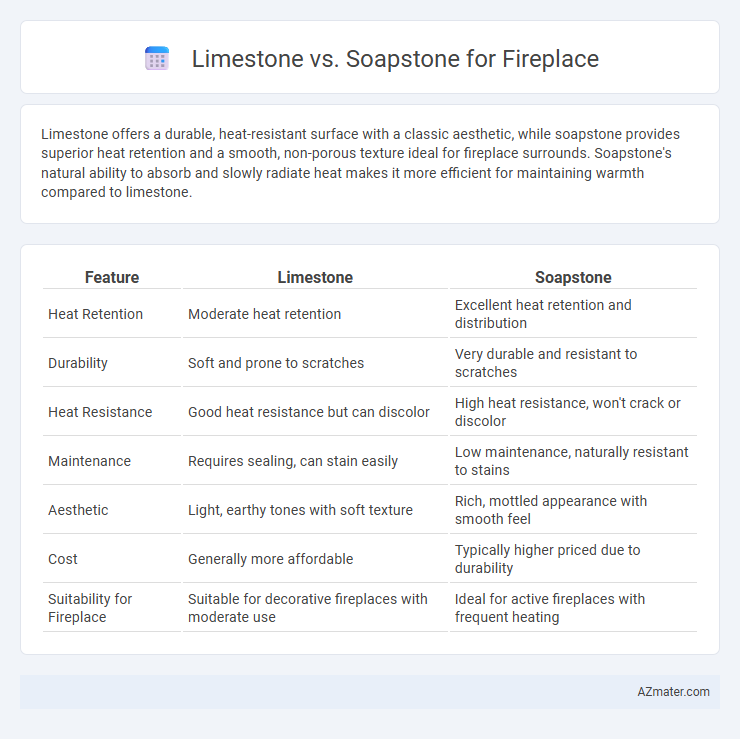Limestone offers a durable, heat-resistant surface with a classic aesthetic, while soapstone provides superior heat retention and a smooth, non-porous texture ideal for fireplace surrounds. Soapstone's natural ability to absorb and slowly radiate heat makes it more efficient for maintaining warmth compared to limestone.
Table of Comparison
| Feature | Limestone | Soapstone |
|---|---|---|
| Heat Retention | Moderate heat retention | Excellent heat retention and distribution |
| Durability | Soft and prone to scratches | Very durable and resistant to scratches |
| Heat Resistance | Good heat resistance but can discolor | High heat resistance, won't crack or discolor |
| Maintenance | Requires sealing, can stain easily | Low maintenance, naturally resistant to stains |
| Aesthetic | Light, earthy tones with soft texture | Rich, mottled appearance with smooth feel |
| Cost | Generally more affordable | Typically higher priced due to durability |
| Suitability for Fireplace | Suitable for decorative fireplaces with moderate use | Ideal for active fireplaces with frequent heating |
Introduction to Fireplace Stone Materials
Limestone and soapstone are popular fireplace stone materials known for their durability and heat resistance. Limestone offers a classic, natural appearance with porous texture, providing moderate heat retention, while soapstone boasts superior heat retention and smooth, dense surface ideal for evenly radiating warmth. Choosing between limestone and soapstone depends on aesthetic preferences and the desired efficiency of heat distribution in fireplace design.
Composition and Characteristics of Limestone
Limestone, primarily composed of calcium carbonate, is a sedimentary rock known for its durability and heat retention, making it a popular choice for fireplace surrounds. Its porous nature allows it to absorb and slowly release heat, providing a steady warmth, but it is susceptible to acid damage and can be less resistant to thermal shock compared to soapstone. Limestone's light, creamy color and fine grain enhance aesthetic appeal, while its relatively softer surface makes it easier to carve intricate designs.
Properties and Appearance of Soapstone
Soapstone, known for its high heat retention and durability, is an excellent choice for fireplaces due to its ability to radiate warmth evenly long after the fire has died down. Its smooth, matte surface usually features a mix of gray, green, and blue hues with subtle veining, offering a unique, natural aesthetic that darkens slightly over time. Compared to limestone, soapstone is denser and less porous, making it more resistant to cracking and thermal shock in high-temperature environments.
Heat Resistance and Performance Comparison
Soapstone exhibits superior heat retention and heat resistance compared to limestone, making it an ideal choice for fireplaces that require sustained warmth and durability. Limestone tends to be more porous and less resistant to high temperatures, which can lead to cracking or discoloration over time when exposed to direct heat. The dense, non-porous structure of soapstone absorbs and radiates heat evenly, enhancing fireplace performance and longevity.
Durability and Longevity Analysis
Limestone offers moderate durability with a Mohs hardness of 3-4, making it more susceptible to scratches and weathering in high-heat environments like fireplaces. Soapstone, with a Mohs hardness of 1, is softer but highly heat-resistant and non-porous, providing excellent thermal shock resistance and long-term durability even with frequent temperature fluctuations. Over time, soapstone maintains structural integrity and resists cracking better than limestone, making it a superior choice for fireplace applications focused on longevity.
Maintenance Requirements for Limestone vs Soapstone
Limestone fireplaces require regular sealing to prevent staining and protect against moisture damage, as the porous nature of limestone absorbs oils and dirt easily. Soapstone, known for its dense and non-porous composition, demands minimal maintenance and is naturally resistant to heat, stains, and moisture, making it ideal for long-term durability. Cleaning limestone involves gentle, pH-neutral cleaners to avoid etching, while soapstone can be maintained with simple soap and water without risking surface damage.
Aesthetic and Design Versatility
Limestone offers a classic, light-toned aesthetic with subtle grain patterns that complement traditional and contemporary fireplace designs, enhancing brightness in interior spaces. Soapstone features a rich, darker color palette with smooth, matte surfaces that develop a unique patina over time, providing versatile design appeal from rustic to modern styles. Both materials exhibit excellent heat resistance, but limestone's neutral hues allow for greater adaptability in diverse decor themes, while soapstone's natural variations create a distinctive, sculptural focal point.
Cost Comparison: Limestone vs Soapstone Fireplaces
Limestone fireplaces generally cost less upfront, with prices averaging between $40 to $70 per square foot, making them a budget-friendly option compared to soapstone. Soapstone fireplaces, priced around $60 to $100 per square foot, offer higher durability and heat retention, which can translate to long-term energy savings despite the initial expense. Choosing between limestone and soapstone depends on balancing upfront installation costs against long-term performance and maintenance benefits.
Environmental Impact and Sustainability
Limestone and soapstone differ significantly in environmental impact and sustainability for fireplaces. Limestone quarrying often involves higher carbon emissions and habitat disruption due to extensive mining processes, whereas soapstone extraction tends to have a smaller ecological footprint because of lower extraction volumes and less energy-intensive processing. Soapstone's durability and resistance to thermal shock also contribute to longer lifespan fireplaces, reducing the need for replacements and further conserving natural resources.
Final Recommendations: Choosing the Best Stone for Your Fireplace
Soapstone offers superior heat retention and durability, making it ideal for long-lasting warmth and resistance to cracking in fireplaces. Limestone provides an elegant, natural aesthetic but is softer and more prone to heat damage, requiring careful maintenance. For a combination of efficiency and longevity, soapstone is the best choice for a high-performance fireplace, while limestone suits decorative purposes in low-heat settings.

Infographic: Limestone vs Soapstone for Fireplace
 azmater.com
azmater.com